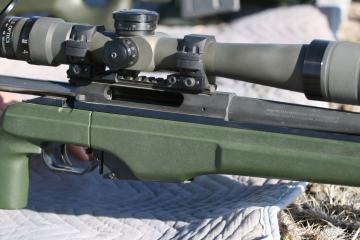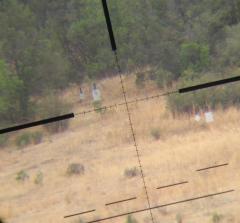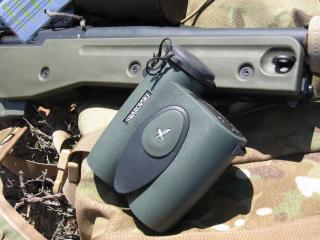Rifle Scope Selection
I cover rifle scope selection criteria extensively in my article,
OPTICS FOR PRACTICAL LONG-RANGE RIFLE SHOOTING. Four recommendations: Leupold Mark 4, 3.5-10x40mm, M1 or M2 knobs, mil-dot or mil-hash reticle. This is the baseline optic I recommend. Leupold tactical scopes are proven, solid, and provide the basic features you need for practical long-range shooting. Get the "First Focal" version if you can afford it. The 4.5-15x50mm version is a good choice too. Buy used if you don't have enough money yet. $800-1200. Nightforce NXS 3.5-15x50mm. The Nightforce scopes have glass a little better than the Leupold, and are more sturdily built. Downside- no first-focal reticle option. $1100 - 1400. US Optics SN3, 3.2-17x44mm. Get metric knobs and a mildot or mil-hash reticle. Get the EREK knob for elevation. These scopes are heavy, but sturdy. They are made in California and USO has good customer service. $1800-2400. Schmidt & Bender PMII, 3-12x50mm. Get metric knobs and P4 or P4-Fine reticle. A plain mildot is available in the P3 reticle, but the P4 is an improvement. This scope is built like a tank, has super clear and bright optics, has a zero stop, is available in all "metric" (mil-based reticle and knob clicks). With optics this clear, 3-12x is enough to make hits to 1000-1200 yards, and the 3-12 is a nice compact scope. S&B also has a 4-16 available, and a 5-25. The 5-25 is an excellent choice for a long-range Magnum intended for shooting 1-3 MOA targets 1000-1500 yards. $2000-2700. Scope Mount Selection
A precise scope and accurate rifle are of no use separately. The scope mount is key to the
accuracy and capabilities of the entire system. Most rifles have a receiver which is tapped for
mounts, upon which rings are mounted, and finally the scope goes in the rings. For long-range
rifles, most people use a single or two-piece base which provides a Picatinny rail surface. Standard
Picatinny rings are bolted to this rail, and the rings hold the scope.
Some rifles and receivers have an integral Picatinny rail, such as the AR-10, SR-25, and Surgeon rifle receiver. These designs remove the need for a separate base; the rings are bolted straight to the receiver. There are mounts for Picatinny rails and proprietary receivers which are a "unified" mount. Instead of having two separate rings, the two ring bases are machined from a single piece of metal, and there is no need for separate rings and bases. The advantage of a unified mount is that there are fewer connectors to come loose and less weight for the same strength or rigidity. Mounts, receivers, or unified mounts can provide a scope mounting incline angle, usually called an "MOA base", referring to a downward angle relative to the bore axis. This is used to utilize more of the scope's internal adjustment ("click") range, and is discussed in detail in OPTICS FOR PRACTICAL LONG-RANGE RIFLE SHOOTING. Range-Finder Selection
Knowing the range of the target is critical to making long-range hits. Between 500 and 1000 yards,
the best .308 Winchester loads are dropping at one inch every four yards forward travel, up to one
inch every yard forward travel. For example, at 700 yards, it drops at about 1/2" per yard. If a
target is 16" in diameter (a pretty large target) and the shooter aims at the center, he has 8" of
vertical error margin.
This margin is used up by rifle and shooter accuracy, accuracy of "data book" drop values compared to current real conditions and load, and ranging error. If we look only at ranging error, that 8" of error margin translates into 16 yards. In other words, the estimated range which is used to look up the drop value, must be within plus or minus 16 yards of the real value. If his range estimate is 25 yards short, the bullet will be 12.5" low, and it will miss the target. There are basically two methods to range long-distance targets. The first method is to "mil" the targets, which means that if the shooter knows the physical dimensions of a distant object, he can use reticle features to compare the apparent size, and use that information to calculate the object's distance. This is the most basic skill and something that every long-range shooter should know how to do, but is error-prone because of three main reasons: 1. object dimensions are not always known, or known accurately; 2. accurately measuring the object's apparent size in the reticle (in mils or MOA), is not precise; and 3. doing math in the field under time pressure is error prone. (I will cover milling targets in a later section of this article series.) The other common method to determine target distance is to use a laser range finder (LRF). These work by bouncing an infra-red (invisible) laser beam off the object and using a computer to turn the time it took to get there and back into a distance in yards or meters. Laser range finders generally work pretty will within their maximum range in good optical conditions, but their performance will degrade when target reflectivity is low, there is sun flare, or the line of sight is not clear. Both monocular and binocular laser range-finders are available. A monocular only has one optic that you can look through, just like a rifle scope or camera, but the binoculars operate like regular binoculars except they have a laser range-finder built in. Binocular LRFs are better for spotting and target location, but they are larger and more expensive.I recommend four range-finders: Burris 7x40 binocular, max 1500 yards. This LRF has relatively poor optics and is large, but it ranges well. $650. Leica 1200 / 1200 Scan monocular, max 1200 yards. This LRF has good optics and is nice and compact. $650. If pressed for price, the 1200 and 1200 Scan models can be found for as cheap as $350 used. This is the best buy. Leica Geovid binoculars, 8x or 10x magnification, max 1300 yards. This LRF has great optics and ranges well, but is large. It is the ultimate tool for target location, spotting, and ranging within 1000 yards. $1800 - 2100. Swarovski 8x Laser Guide monocular, max 2000 yards. This LRF has good optics and is nice and compact. It ranges further than anything under $6000. Price is $900 new, $700 used. To get 2x the ranging ability, you have to spend at least 10x the cost of the range-finder. If you regularly need to range targets from 800-2000 yards, this is the best choice. Its only downside is the large reticle which is hard to pinpoint on targets.
|



